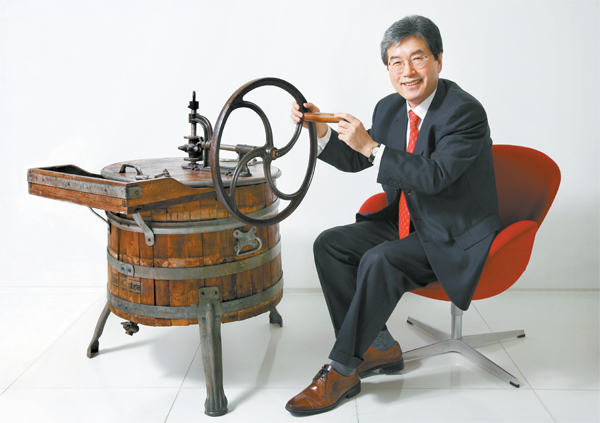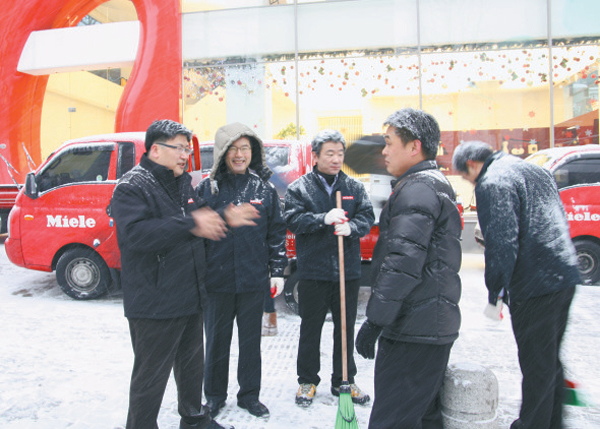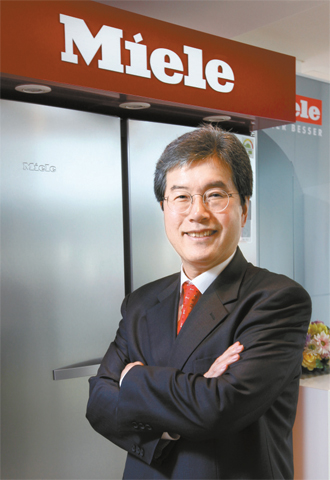Made in Germany, Miele appliances at home in Korea

Miele Korea CEO Ahn Kyu-moon displayys a wooden-tub washing machine Miele introduced in 1901 at the headquarters of Miele Korea in Yeoksam-dong, southern Seoul. Miele Korea is at the forefront of the growing popularity of European home appliances in Korea. By Park Sang-moon
Miele Korea, which represents a premium German brand with a 115-year history, is at the forefront of the European invasion.
The Korean office of the Gutersloh-based company boasts the widest portfolio of products among European home electronic appliance makers in Korea. It sells free-standing products, such as refrigerators, clothes washers and dryers, vacuum cleaners, dishwashers and steam ovens, as well as built-in products. It introduced built-in electronic home appliances in Korea in 1993, starting in Seoul’s upscale areas Hannam-dong, Seongbuk-dong, Dogok-dong and Bangbae-dong.
According to the company, Miele Korea’s retail revenue growth averaged 68 percent annually over the past three years. Few foreign home appliance sellers in Korea and few among Miele’s 48 foreign branches can match those numbers, it said.
Ahn Kyu-moon, who has steered Miele Korea since its launch in 2005, cited rising incomes and an appreciation among Koreans of sophisticated and distinctive products.
However, Miele’s swift move to adapt its marketing strategy to the changing business environment was another reason for its competitiveness in a domestic market dominated Samsung Electronics and LG Electronics, the 63-year-old CEO said. Ahn, a former executive of Ssangyong Corporation, a trading company, introduced an online sales system at Miele, which has become standard in all Miele foreign offices.
Ahn sat for an interview at Miele Korea’s headquarters in Yeoksam-dong, southern Seoul.

Miele Korea employees and executives, including CEO Ahn Kyu-moon, second from left, sweep snow in front of Miele Korea headquarters in Yeoksam-dong, southern Seoul. Provided by the company
A. Miele was founded in Herzebrock in 1899 by Carl Miele and Reinhard Zinkann, first as a maker of cream separators. It is a family managed company now under the management of the fourth generation, Markus Miele and Reinhard Zinkann. It cherishes its traditions. Miele has about 17,000 employees and executives around the world, and 60 percent of them have worked there for 25 years or more.
Miele Korea beagan with a project by Ssangyong Corporation to import Miele products in 1990. Then in 1992, an independent entity, KoMie Company, was established as an exclusive Miele dealer in the Korean market. Miele Korea took it over in 2005 and it now has 85 employees nationwwide.
Miele products are sold across Korea through 192 department stores and 22 proxy sales outlets. Sixteen major Internet shopping malls also sell our products.
What is your assessment of where your company is in the Korean market?
We conducted a survey of the Korean home electronic appliance market at the end of last year. The survey asked consumers about their awareness of our brand. According to the survey, 28 percent of Korean consumers knew our brand. Of course, 98 to 99 percent were aware of Samsung Electronics and LG Electronics, but that still showed that we are the third most well known home appliance maker in Korea, and we are very much encouraged by that. Department stores in Korea also recognize us as one of the three top home appliance brands in Korea. We are ahead of Dongbu Daewoo Electronics.
Why are people buying your products? How are they different from other products sold in Korea?
We have a design philosophy in which we make products that should look new even after being used for 10 years. We are making products that a granddaughter wants to inherit from her grandmother. Our products are called white products, because almost every product except for vacuum cleaners comes only in white. A key to the design of our products is stability and harmony. Design should be something that helps maximize function, not dictate or limit function. There has long been a design-oriented approach among Korean home appliance makers, but those designs could compromise function. A growing number of people here understand that.
Status as a premium foreign brand would also seem to help boost your popularity here, but being foreign is not always an advantage. Some consumers here are hesitant to buy foreign cars because their after-sales service is not great due to the distance from their headquarters. How is the quality of your service?
Our policy is that any of our customers’ requests for after-sales service should be met within 24 hours. Components of our products are a little bit expensive. We can’t help it. But there are not many complaints about malfunctions in our products. About eight in 10 requests for after-sales service are to reinstall them when customers move to another place. We are the only home appliance importer in Korea that operates an after-sales service department directly, not through agencies.
You started the first online branch among Miele’s foreign branches. Does that mean you are shifting your focus from high-end consumers to the mass market?
Striving for a mass market is nothing but suicide for us. If a luxury brand declares that it is in mass production, it no longer is a luxury brand. Neither can a mass market brand reimagine itself as a luxury product. They have different DNA.
Miele first made a cream separator. Its cost was the same as that of five cows, or the equivalent of three and a half years’ wages for a housemaid. The company sold its first separator only after two and a half years had passed. If that were an ordinary company in Korea, it would have tried to sell products at any price through discounted sales. But the company proved with its patience that it was aiming for a different target market.

From right, Reinhard Zinkann, second from right, co-chairman of Miele, with Miele Korea CEO Ahn Kyu-moon, second from left, and other Asian representatives of Miele at a restaurant in Seoul in 2013 after a budget presentation by Asian branches at Miele Korea in Yeoksam-dong, southern Seoul; Ahn shows Miele co-chairman Markus Miele the refurbished showroom of Miele Korea during a 2011 visit; Ahn lectures to business students at Ewha Womans University in Seoul. Provided by the company
There was strong opposition to it in the beginning. There was an opinion within the company that I did not properly understand Miele’s philosophy and tradition because I was not a German.
I faced similar opposition when I suggested that we buy a building for Miele Korea. At the time, there were some other German home appliance companies in Korea, but they were renting small offices. I told them we needed the building to show Koreans that we didn’t have any plans whatsoever to withdraw from the Korean market. Likewise, in order to build a strong presence, we needed some marketing through which we could expose our products to a wider range of consumers, and that was by online marketing.
Has the online marketing not compromised your quality?
We kept that in mind from early on and it turned out that online shopping made our price principles clearer. We have adhered to only one price for each product. We make sure that all products sold through online shopping have the same price tag as products sold through our branches. That sometimes gave us hard time at department stores, because we did not comply with their regular discount sales pitches. But as we tried to explain our principle and more consumers understood our firm stance on quality over price, they began to understand us.
Are other Miele branches also adopting the online sales system?
It is a universal sales principle of Miele. Many executives from other foreign branches of Miele are visiting us to get a one-point lesson on the online business. It has become almost customary that any new office head in Asia comes here and gets a weeklong lesson from us. We have become a “Miele West Point” in Asia, so to speak. Since 2011, executives from Japan and Singapore have visited us. Ande the head of the Hong Kong office is planning to visit us soon.
What’s the biggest strength of Miele Korea compared with other Miele foreign branches?
We are good at paradigm shifts. In the early years of Miele Korea, we earned more than 70 percent of our revenue from B2B [business to business] sales, in particular building contractors’ projects. But that put us in a very precarious situation. If the construction industry went awry, we would suffer. So we thought that going to B2C [business to consumer] was crucial to survival. One idea was online marketing; it was a success. Last year, only 10 percent of our revenue came from B2B. This year, it will be below 1 percent.
What is your goal this year?
As in previous years, we are anticipating double-digit growth. But sustainability is more important than fast growth. I met with the Miele chairman recently and said to him that if the mother company can survive for 100 years, we, Miele Korea, woulod become a centenarian, too. Some companies trigger problems when they aim for a jackpot. We are not focused on that. We are focused on bolstering our fundamentals.
BY MOON GWANG-LIP [joe@joongang.co.kr]

·February 1977: Graduated from Kookmin University with a bachelor’s degree in economics
·January 1977: Joined Ssangyong Corporation
·June 1982-December 1983: Representative at Ssangyong Kuwait Office
·July 1987-December 1991: Ssangyong (USA) Inc.
·January 1992-December 1996: General manager of Cement & Building Materials Deptartment, Ssangyong Corporation
·January 1997-June 2000: Representative at Ssangyong Thailand
·March 2001-January 2003: Vice president of Cominet Co. Ltd.
·February 2003-June 2005: CEO and president of KoMie Company Ltd.
·July 2005-present: CEO of Miele Korea










with the Korea JoongAng Daily
To write comments, please log in to one of the accounts.
Standards Board Policy (0/250자)